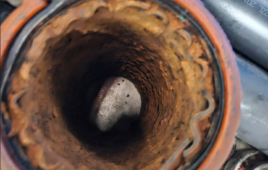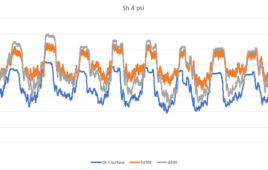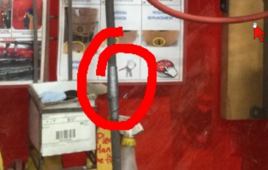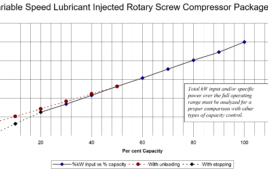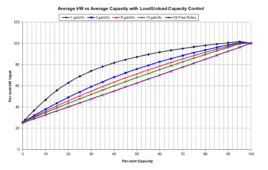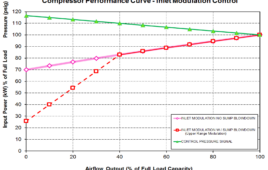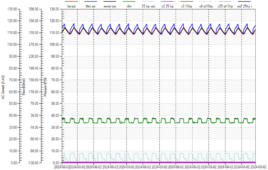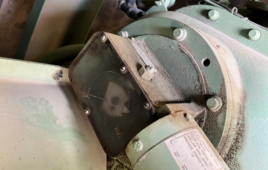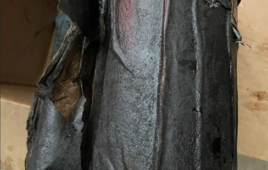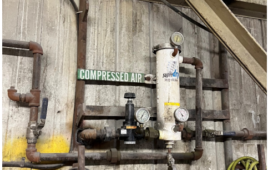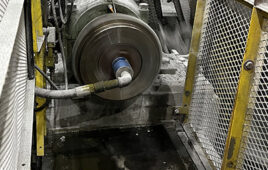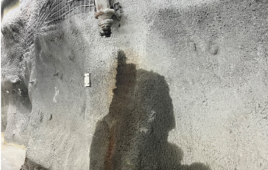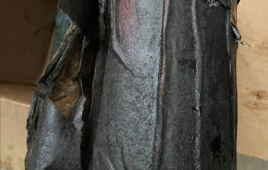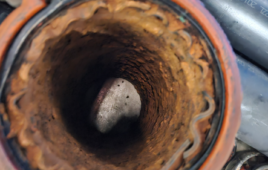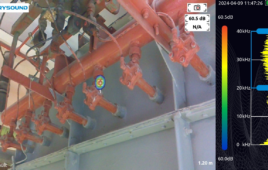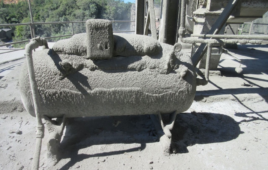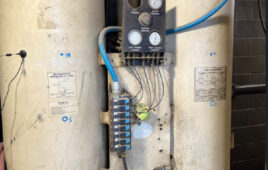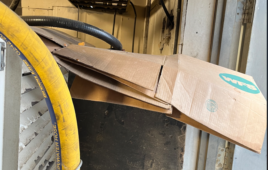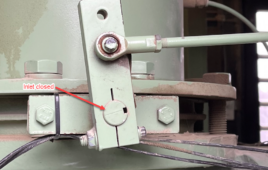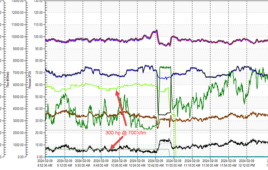The typical piping installed in industrial plants and shops is made of steel, and as a result may be subject to rusting and contamination. Fig. 1 and 2 show what was found at a heavy industrial plant with the air compressors taking in polluted air. Rusting and contamination in compressed air system piping can lead […]
Compressed air fail: Pressure increase
Normally when measuring the pressure gradient of a compressed air system in an industrial site, the pressure at the compressor discharge is the highest of all locations. Once the compressed air travels through piping, filters, air dryers, and other components — each causing restriction to flow — the pressure at the far end of the […]
Compressed air fail: Duct tape leak repair
I found a leak, it’s hissing loud, Compressed air whistling, oh so proud. I grabbed some duct tape, rolled it tight, Thinking I’d fix this leak tonight. But oh, that tape — it flaps and flails, Like it’s on a ship with stormy sails. The air just laughed, a mocking squeak, “You can’t fix me, […]
Compressed air fail: Variable speed
In this blog post, we will discuss the fifth of five industrial compressor capacity control modes. A very efficient method of controlling a compressor at part load using variable speed mode. With this type of compressor, an electronic drive is fitted to a specially designed compressor with air end components matched to the intended speed […]
Compressed air fail: Load/unload
In this blog post, we will discuss the third of five industrial compressor capacity control modes. A moderately efficient method of controlling a compressor at part load uses load/unload mode with adequately sized storage receiver capacity. With this mode, a pressure switch, or electronic control, is used to provide load and unload signals to the […]
Compressed air fail: Modulating mode
In this blog post, we will discuss the second of five industrial compressor capacity control modes. The least efficient method of controlling a compressor at part load is using modulating mode by way of pneumatically controlled inlet valve control. With this mode, a pneumatic system detects the compressor discharge pressure and compares it to a […]
Compressed air fail: Start/stop mode
In this blog post, we will discuss the first of five industrial compressor capacity control modes. The simplest method of controlling a compressor is Start/Stop mode using pressure switch control. This control simply turns on the compressor to run at full load when the pressure hits a lower pressure level — and turns off the […]
NFPA awards 20 fluid power scholarships
The NFPA Education and Technology Foundation has awarded 20 $2,000 scholarships to students pursuing fluid power related fields of study. A minimum GPA of 2.5 out of 4.0, a 500-word essay, and a letter of recommendation were required from each applicant. The NFPA Foundation’s goal is to help graduating high school students, and individuals enrolled…
Danfoss Power Solutions names Gurumurthy as SVP of Global Operations
Danfoss Power Solutions has appointed Sriram (Shree) Gurumurthy as SVP of Global Operations, effective immediately. Previously VP of Global Manufacturing Strategy, Gurumurthy will continue reporting directly to Eric Alström, President of Danfoss Power Solutions, and will join the Power Solutions Leadership Team. He is based in Eden Prairie, Minn. Gurumurthy will lead the newly created…
NFPA announces 2024 Robotics Challenge Scholarship winner
Evan Tan of Conway, Ark. has been announced as the winner of the 2024 NFPA Robotics Challenge Scholarship. According to the NFPA, the scholarship program received strong applications from students across the country who used pneumatics in robotics competitions. This scholarship program helps build awareness of fluid power benefits and careers among high school students.…
Compressed air fail: Variable displacement
There are five different capacity control modes available for use with North American-built large industrial air compressors. It pays to know how each mode works, especially if you operate or service air compressors or happen to have your compressors operating in one of the least efficient modes. The accompanying photograph shows just one design that […]
Compressed air fail: Air-oil separator failure
A compressed air auditor regularly flow-tested the compressors under his study. This generally would be done if the air compressor was drawing low amps — a telltale sign that the unit is producing low flow output — or if the compressor has excessive hours. Often times, internal wear due to age will reduce output […]
Why use point-of-use dryers with compressed air systems?
It is common to see the air in a complete plant dried by a desiccant dryer only to service one small end-use that is subject to freezing temperatures. The purge from a large desiccant dryer is much more costly than that of a small point-of-use dryer, which can be placed on the outdoor feed. The […]
Compressed air fail: No log
A compressed air auditor was excited to see logbooks for each of the compressors at a large mineral processing facility. Each book was protected from the environment by a really nice orange plastic case. The auditor was interested to see the compressor history and opened the book, only to discover it was blank — no […]
Compressed air fail: Clutch play
A compressed air auditor recently performed an energy audit at a mineral processing facility. Plant personnel were constantly complaining about production outages due to low pressure. The problem was that when the pressure dips down below 80 psi, the drive clutches on the large ball mills — that grind the processed down minerals to powder […]
Compressed air fail: Condensate disposal
A compressed air auditor found, during a site visit to a mine, that compressed air condensate was left to drain from stopcock at the bottom of piping low spots. The oily condensate pooled on the ground, creating a slippery mess that polluted the environment and caused a safety hazard. This mine had no air dryers […]
Compressed air fail: The bag method
Did you know that garbage bags have a use in the compressed air industry? The use of garbage bags to determine compressed air leakage, is described in the U.S. Department of Energy’s (USDOE) MEASUR tool and is a straightforward and cost-effective method for roughly estimating air leaks in a compressed air system. This technique is […]
Compressed air fail: Pipe and tank corrosion
Corrosion in steel pipes and storage receivers within compressed air systems is a common issue that can significantly impact system efficiency, safety, and longevity. This process is primarily driven by the presence of water and acid condensate, both of which are common byproducts in compressed air environments. Understanding how corrosion occurs can help in implementing […]
Compressed air fail: Dust collectors
Dust collector reverse pulse cleaning is commonly deployed in any industry that creates powdered dust. Through the years, it is common to see expensive failures of these devices that consume excessive amounts of compressed air. Often times, these failures go undetected. Dust collector reverse pulse cleaning is a highly efficient method for removing accumulated dust […]
Compressed air fair: Keep it cool, not cooked
Air-cooled air compressors are crucial to keeping the production process running in many industries; they work by turning power into usable energy. Their performance, however, depends heavily on their ability to stay cool. If dust and debris clog up a compressor, it can overheat, work less efficiently, and cost more to operate. Fig. 1 and […]
Compressed air fail: Happy ending
Tom, a diligent plant engineer at a mid-sized manufacturing facility, faced persistent problems with his compressed air system powering his crucial production lines. Despite repeated attempts to fix various symptoms — frequent drops in pressure, excessive energy consumption, and sporadic equipment failures — the problems persisted, causing costly downtime and frustration on the factory floor. […]
Compressed air fail: Dryer false economy
A wood products company had an aging heatless 1,000 cfm desiccant air dryer, being used to condition the compressed air produced by two 100-hp compressors in their processing facility. After working for many years, the dryer controller failed and had to be replaced. Replacement parts could not be found, so the local electricians came up […]
Compressed air fail: Poor man’s ducting
From time to time, compressed air auditors find air-cooled air compressors located in small rooms where the ventilation is inadequate. Most of the time, in properly designed rooms, the heat the compressors produce is ducted out of the room through metals ducting — often, it will be directed to cool areas of the plant in […]
Compressed air fail: Inlet valve problems
A mining complex was experiencing low pressure events — even though its 14 large compressors were all running. The pressure was adequate during most of the day, but during peak demand times, the pressure sagged to unacceptable levels. This, of course, caused complaints from the workers. The pressure settings of the compressors were already set […]
Compressed air fail: Capacity surprise
When doing a compressed air audit, it is always recommended to measure the important parameters of the system and analyze the data carefully. Typically, pressure and power (or amps) are monitored, but in some cases measurement of flow comes in handy. In the case of a large plumbing component manufacturer, the installation of flow meters […]

